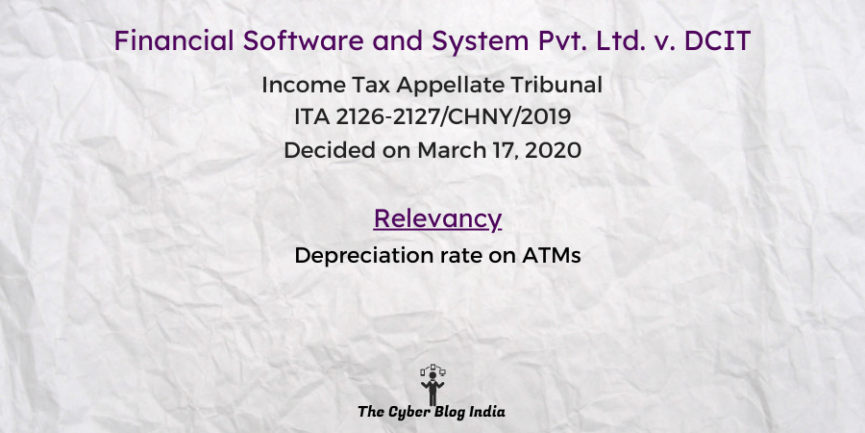Financial Software and System Pvt. Ltd. v. DCIT

Financial Software and System Pvt. Ltd. v. DCIT
In the Income Tax Appellate Tribunal
ITA 2126-2127/CHNY/2019
Before Mr I.R. Rao (Accountant Member) and Mr D.R.L. Reddy (Judicial Member)
Decided on March 17, 2020
Relevancy of the Case: Depreciation rate on ATMs
Statutes and Provisions Involved
- The Information Technology Act, 2000 (Section 2(1)(i))
- The Income Tax Act, 1961 (Section 143(3))
Relevant Facts of the Case
- The appellant provides Automated Teller Machine (ATM) management services. Earlier in the AY 2015-16, tt incurred a loss of ₹5,35,75,794.
- However, the Assessing Officer and Deputy Commissioner of Income Tax allowed the depreciation on ATMs only at the rate of 15%.
- Hence, the appellant has filed this appeal against the disallowance of the 60% depreciation rate on ATMs.
Prominent Arguments by the Advocates
- The appellant placed the reliance in favour of the assessee’s own case in ITA 2564-2565/Chny/2018 as well as the Bombay HC judgement in CIT v. Saraswat Infotech Ltd (2013).
- On the other hand, the departmental representative of CIT relied on the decision of the Karnataka HC in Diebold Systems Pvt Ltd v. Commissioner of CT (2006).
Opinion of the Bench
- The definition of the computer in Section 2(1)(i) of the Information Technology Act, 2000, includes ATMs. To illustrate, ATM has a card reader, biometric reader, cash camera, consumer awareness mirrors, note validation technology, note keeping capacity in a secured deposit box, self-diagnosis and capability of failure recovery.
- The bench relied on Royal Bank of Scotland N.V. v. DCIT and CIT v. Datacraft India Ltd. In the former case, the tribunal considered ATM a computer. Moreover, ATM has built-in computer software that decodes the information, processes it, and gives the output. It is a computer terminal that functions through a magnetically encoded debit card. Therefore, an ATM machine and a computer use almost the same software. In the latter case, routers and switches or any other input or output device used with the computer capable of performing logical, arithmetical and memory functions were considered a computer. ATM also performs these functions.
- In DCIT v. Global Trust Bank Ltd, the bench held that the ATM is a computerised telecommunication device connected to the main server. It is part of the computer network. Accordingly, LAN, WAN and ATM equipment is also considered in the definition of computer.
- In CIT v. Orient Ceramics and Industries Ltd., 60 % depreciation was allowed on UPS as it is considered an integral part of the computer system. It prevents the loss of data due to power disruptions. Similarly, ATM is also part of ‘computer’ for the banking industry as it can’t function without a computer.
- Previously, the appellant has secured favourable judgements on the issue of depreciation on ATMs.
Final Decision
- As a result, the tribunal allowed the appeal and directed DCIT to conduct its assessment at a 60% depreciation rate.
